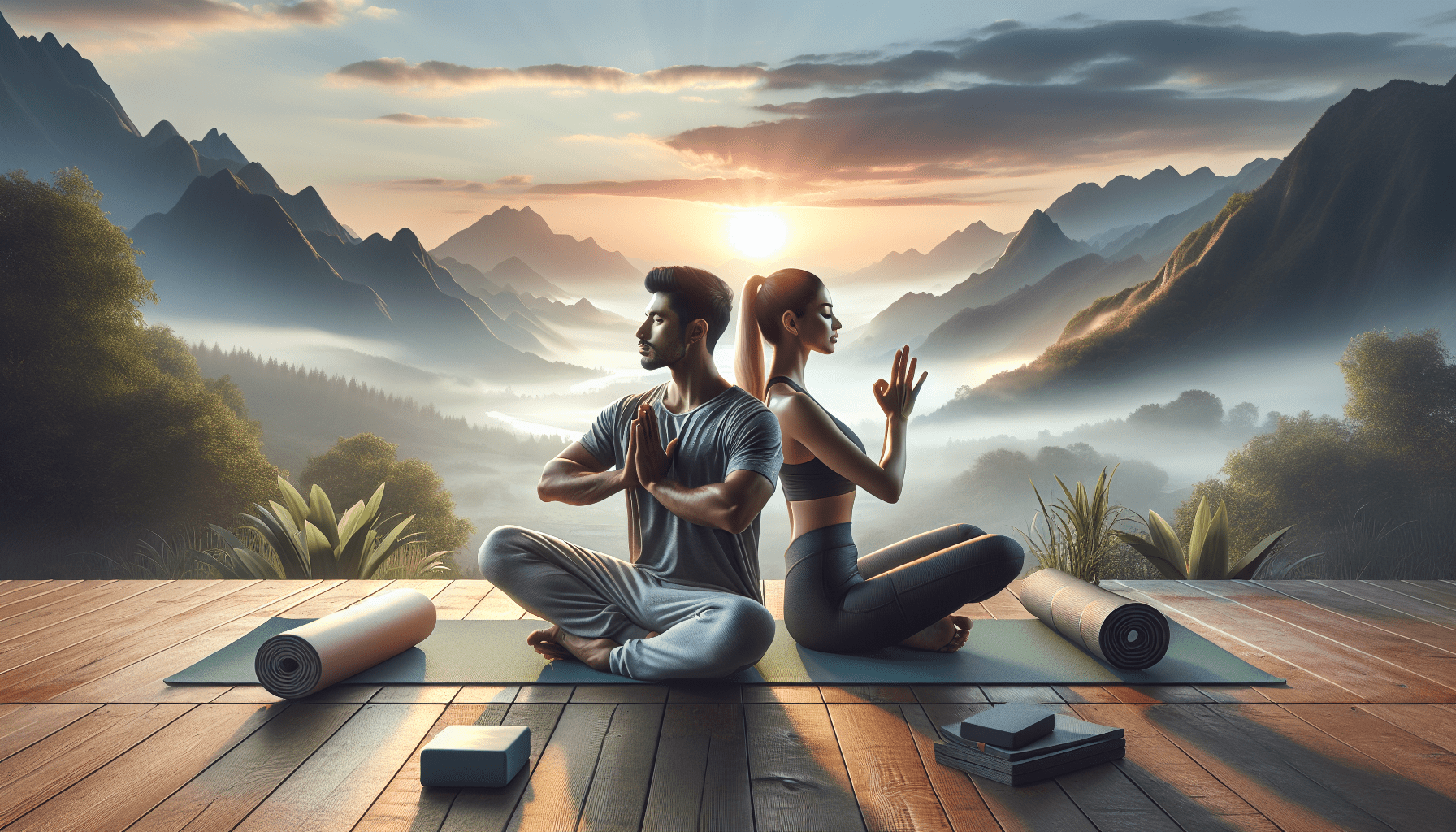If you’re considering trying out a yoga class for the first time, you may have some questions and uncertainties. Don’t worry, we’ve got you covered! As a yoga instructor who specializes in working with beginners, I’m here to provide you with some helpful tips and insights to ensure your first yoga experience is enjoyable and stress-free. From what to wear and bring to the studio to understanding basic yoga poses and class etiquette, we’ll explore all the essentials so you can confidently step onto your mat and embrace the benefits of this ancient practice. So, let’s dive in and discover what to expect in your first yoga class!
The Benefits of Yoga
Yoga is an ancient practice that offers a wide range of benefits for both the body and mind. Whether you’re a beginner or more experienced, incorporating yoga into your routine can have a positive impact on your overall well-being. Here are some of the key benefits of practicing yoga:
Improves flexibility and strength
One of the main advantages of yoga is its ability to improve flexibility and strength. Through a combination of gentle stretching and holding poses, yoga helps to lengthen and loosen tight muscles, making them more supple and pliable. This increased flexibility can improve your range of motion and help prevent injuries.
In addition to flexibility, yoga also builds strength. Many yoga poses require you to use your own body weight as resistance, which helps to strengthen your muscles, particularly in your core, arms, and legs. Regular practice of yoga can help tone and sculpt your body, giving you a leaner and more defined physique.
Reduces stress and anxiety
In today’s fast-paced and hectic world, stress and anxiety have become increasingly common. Yoga offers a calm and peaceful oasis where you can escape from the pressures of daily life. The combination of physical movement, breathwork, and meditation in yoga helps to activate the relaxation response in your body, reducing the production of stress hormones and promoting a sense of calm and tranquility.
Numerous studies have shown that practicing yoga regularly can significantly reduce stress and anxiety levels. It provides a space for you to disconnect from the outside world and focus on the present moment, allowing your mind to become more centered and clear. The breathing techniques taught in yoga can also be utilized in other stressful situations, enabling you to better manage and cope with stress in your everyday life.
Enhances mind-body connection
Yoga is not just a physical practice; it is an opportunity to connect with your body and mind on a deeper level. Through the practice of yoga, you can cultivate a greater sense of awareness and mindfulness.
The deliberate and conscious movements in yoga require you to pay attention to the sensations in your body, the alignment of your posture, and the rhythm of your breath. This heightened awareness allows you to develop a stronger mind-body connection, where you can listen to the signals your body is sending you and respond accordingly.
By developing a deeper mind-body connection, you can become more attuned to your physical and emotional needs, leading to better overall health and well-being.
Choosing the Right Class
If you’re considering trying yoga for the first time, choosing the right class is crucial to ensure a positive and enjoyable experience. Here are some factors to consider when selecting a yoga class:
Determine your fitness level
Before selecting a yoga class, it’s important to assess your fitness level. If you’re new to exercise or have any pre-existing health conditions, it’s advisable to start with a beginner-friendly class. These classes typically focus on the fundamentals of yoga and offer modifications for different fitness levels.
On the other hand, if you’re more active and looking for a challenging workout, you may want to explore more advanced classes such as Vinyasa or Power Yoga. These classes often involve faster-paced sequences and more demanding poses.
Consider your goals and preferences
When choosing a yoga class, it’s important to consider your personal goals and preferences. Are you looking to incorporate yoga into your fitness routine, or are you seeking a more spiritual or meditative experience? Some classes may be more fitness-oriented, while others may place a greater emphasis on relaxation and stress reduction.
Additionally, consider the class size and atmosphere that you’re comfortable with. Some people thrive in larger, more energetic classes, while others prefer smaller, more intimate settings. Exploring different styles and class environments can help you find the perfect fit for your needs.
Research different yoga styles
There are numerous styles of yoga available, each with its own unique focus and benefits. Some common yoga styles include Hatha, Vinyasa, Ashtanga, and Yin. It’s helpful to research and understand the key characteristics of each style to determine which one resonates with you.
Hatha yoga is a gentle and slow-paced style that is suitable for beginners. Vinyasa yoga, on the other hand, involves flowing movements and synchronized breath, making it more dynamic and physically challenging. Ashtanga yoga follows a set sequence of poses and is known for its rigorous and disciplined approach. Yin yoga, in contrast, involves holding poses for extended periods to target the deep connective tissues of the body.
By familiarizing yourself with different yoga styles, you can choose a class that aligns with your goals and preferences.
What to Wear
When attending a yoga class, it’s important to wear clothing that allows for comfort and freedom of movement. Here are some guidelines to help you choose appropriate attire:
Wear comfortable, breathable clothing
Yoga involves a lot of movement and stretching, so it’s essential to wear clothing that allows for ease of movement. Opt for lightweight, breathable fabrics that wick away sweat and keep you cool during your practice. Materials such as cotton, bamboo, or moisture-wicking synthetic blends are ideal choices.
Choose fitted attire to avoid distractions
While comfort is important, it’s also essential to choose clothing that fits snugly to avoid distractions during your practice. Loose or baggy clothing can get in the way and make it difficult for the instructor to observe and correct your alignment. Fitted tops and bottoms will help ensure that you can move freely without any hindrance.
Consider layers for temperature changes
Yoga studios are often kept at a comfortable temperature, but it’s still a good idea to wear layers that you can easily remove or add as needed. This allows you to adjust to your own comfort level, especially during warm-up exercises or cool-down periods. Layering also provides protection against cold temperatures if you’re practicing outdoors or in a drafty studio.
By following these guidelines, you can ensure that your clothing enhances your yoga practice rather than detracting from it.
What to Bring
To make the most of your yoga class, there are a few essential items you should bring with you. These items will help enhance your comfort and support your practice. Here’s what you’ll need:
A yoga mat
A yoga mat is a fundamental item for any yoga class. It provides a cushioned and non-slip surface for you to practice on, ensuring your safety and comfort. When choosing a mat, look for one that is thick enough to provide adequate cushioning but not too bulky to carry around. Additionally, consider the texture and grip of the mat to prevent any accidental slips during your practice.
A towel or blanket
Having a towel or blanket can be beneficial during your yoga practice. You can use it to wipe away sweat or provide additional padding for certain poses. If you tend to get cold easily, a blanket can also be used for warmth during relaxation or meditation.
A water bottle
Staying hydrated is important during any physical activity, including yoga. Bring a water bottle with you to your class to ensure you can sip water whenever you need it. It’s important to listen to your body and hydrate accordingly throughout your practice.
By bringing these essential items, you’ll be well-prepared and comfortable for your yoga class.
Arriving at the Studio
Arriving at the yoga studio with ample time allows you to settle in and prepare yourself mentally and physically for the class. Follow these steps to ensure a smooth and stress-free arrival:
Arrive early to get settled
It’s recommended to arrive at least 10-15 minutes before the scheduled class time. This extra time allows you to check-in, find a suitable spot in the studio, and set up your mat and any props you may need. Arriving early also gives you an opportunity to relax, settle your mind, and transition from the outside world into the yoga environment.
Check in at the front desk
When you arrive at the studio, check-in at the front desk or reception area. This is where you’ll sign in for your class, pay any fees if applicable, or inquire about any specific instructions or guidelines for the studio. The staff is there to assist you and address any questions or concerns you may have.
Find a spot in the studio
After checking in, find a spot in the studio that feels comfortable to you. Consider factors such as proximity to the instructor, lighting, temperature, and available space. Some people prefer to be closer to the front for a better view and guidance from the teacher, while others may prefer to be towards the back for a more private and less distracting experience.
Once you’ve found your spot, set up your mat and any props you have brought. Take a moment to center yourself and prepare for the class ahead.
Class Etiquette
Maintaining proper etiquette during a yoga class is essential to create a harmonious and respectful environment for everyone. Here are some guidelines to follow:
Respect others’ space and silence
In a yoga class, it’s important to respect the space and privacy of others around you. Place your mat with reasonable spacing between your neighbor’s mat to ensure everyone has sufficient room to move and stretch comfortably.
During the class, try to observe silence unless necessary. This includes keeping conversations to a minimum and refraining from using electronic devices or anything that may create unnecessary noise or distractions.
Follow the teacher’s instructions
The yoga teacher is there to guide and support you throughout the class. It’s essential to listen carefully to their instructions and follow along to the best of your ability. If you’re unsure about a particular pose or technique, don’t hesitate to ask for clarification or assistance.
It’s important to remember that yoga is a non-competitive practice, and each person’s experience and abilities may vary. Avoid comparing yourself to others and focus on your own journey.
Avoid leaving early unless necessary
To maintain a respectful and uninterrupted class experience, it’s advisable to stay for the entire duration of the class unless there is an urgent need to leave. Exiting the class early can disrupt the flow and concentration of other participants.
If you do need to leave early, try to position your mat near the door and notify the instructor beforehand. Leave the class quietly and with minimum disruption to ensure a peaceful atmosphere for others.
By adhering to these etiquette guidelines, you’ll contribute to a pleasant and enjoyable yoga experience for yourself and others.
Preparing for the Class
To make the most of your yoga class, it’s important to prepare your mind and body beforehand. Here are some tips to help you get ready:
Hydrate before class
Yoga classes can be physically demanding, and it’s important to stay hydrated throughout. However, it’s advisable to hydrate before the class rather than drinking excessive amounts of water during the practice. Drinking too much water immediately before class may cause discomfort or the need for frequent trips to the restroom.
Sip water throughout the day leading up to your class to ensure you’re adequately hydrated. This will help maintain your energy levels and prevent dehydration during your practice.
Avoid heavy meals before class
Digesting a heavy meal can make you feel uncomfortable and sluggish during your yoga practice. To avoid discomfort, it’s best to avoid eating a large meal at least two to three hours before your class. If you do feel the need to eat something, opt for a light snack such as a piece of fruit or a small handful of nuts.
On the other hand, practicing yoga on an empty stomach may also lead to discomfort, especially if you’re prone to low blood sugar. If you need a snack, choose something light and easily digestible to fuel your body without weighing you down.
Stretch and warm up before class
To avoid injuries and optimize your performance, it’s advisable to stretch and warm up before attending a yoga class. Gentle stretches, such as neck rolls, shoulder rolls, and spinal twists, can help to loosen up your muscles and increase your range of motion.
Additionally, it’s beneficial to engage in a short warm-up routine that includes light cardiovascular activity such as brisk walking or dynamic movements like jumping jacks. This will increase blood flow to your muscles, raise your body temperature, and prepare your body for the physical demands of the class.
By taking these preparatory steps, you’ll set yourself up for a more comfortable and effective yoga practice.
During the Class
Once the class begins, it’s important to listen to your body, be mindful of your limitations, and cultivate a sense of presence and awareness. Here are some tips for your yoga practice:
Listen to your body
Yoga is a personal practice, and it’s crucial to honor and respect your body’s needs and limitations. Pay attention to any sensations, discomfort, or pain that you may experience during the class. If a pose feels too intense or causes pain, modify or skip it altogether. Remember that there’s no judgment in yoga, and it’s more important to prioritize your safety and well-being.
Take breaks as needed
It’s perfectly acceptable to take breaks during your yoga practice if you need to catch your breath or rest. Listen to your body and allow yourself the space to take breaks whenever necessary. Use child’s pose, a resting position that involves kneeling and folding forward with your forehead on the mat, as a resting pose whenever you need a moment of recovery.
Taking breaks will help you avoid overexertion and give you the opportunity to recharge so you can fully participate in the rest of the class.
Focus on your breath
Throughout the class, focus on your breath and use it as a tool to anchor your mind and deepen your practice. Take slow, deep breaths in and out through your nose, allowing your breath to guide your movements. By connecting your breath with your movements, you can cultivate a sense of relaxation, presence, and mindfulness.
If you find your mind wandering, gently bring your attention back to your breath and the present moment. This practice of mindfulness can help you reap the full benefits of your yoga practice, both physically and mentally.
By following these tips, you’ll create a nurturing and fulfilling yoga experience for yourself.
Common Yoga Poses for Beginners
As a beginner, it’s helpful to familiarize yourself with some of the common yoga poses that you’re likely to encounter in a class. Here are three foundational poses to get you started:
Mountain Pose
Mountain Pose, also known as Tadasana, is a standing pose that serves as the foundation for many other standing poses. Start by standing tall with your feet hip-distance apart and your arms at your sides. As you ground down through your feet, imagine yourself as a strong and steady mountain. This pose helps improve posture, balance, and body awareness.
Downward Facing Dog
Adho Mukha Svanasana, commonly known as Downward Facing Dog, is a pose that stretches and strengthens the entire body. Begin in a high plank position, then lift your hips up and back, creating an inverted “V” shape with your body. Press your palms into the mat, lengthen your spine, and reach your heels toward the ground. Downward Facing Dog is a great pose for building strength in the arms, legs, and core while also stretching the hamstrings and shoulders.
Warrior I
Warrior I, or Virabhadrasana I, is a standing pose that builds strength and stability in the legs and core. Start in a lunge position with your right foot forward and your left foot back. Align your right knee directly over your ankle and lift your arms overhead, gazing upward. Warrior I encourages grounding and strength while also stretching the hip flexors and improving balance.
These poses are just a starting point, and there are countless other poses to explore as you progress in your yoga journey. Remember to listen to your body and modify poses as needed to suit your individual needs and abilities.
Ending the Class
As the class comes to a close, it’s important to take the time to cool down and reflect on your experience. Here are some steps to wrap up your yoga practice:
Cool down and relax
The cool-down period after your yoga practice helps transition your body from a state of movement to a state of rest. During this time, the instructor may guide you through gentle stretches or lead you into a relaxation pose, such as Corpse Pose (Savasana). Allow yourself to fully unwind and let go of any remaining tension in your body and mind.
Thank the teacher and fellow students
Before leaving the class, take a moment to thank the instructor for guiding you through the practice. Expressing gratitude not only shows your appreciation but also creates a positive and uplifting energy in the room. If you feel comfortable, you can also thank your fellow students for sharing the practice with you.
Reflect on your experience
As you leave the studio, take a few moments to reflect on your yoga practice. Notice any physical, mental, or emotional shifts that may have occurred during the class. Appreciate the effort and dedication you put into your practice and carry the positive energy and sense of well-being with you as you move on with your day.
Yoga is a journey that unfolds uniquely for each individual. By staying committed to your practice and embracing the benefits it offers, you can continue to unlock the secrets of this ancient art and discover the profound impact it can have on your overall health and well-being.
Remember, yoga is not just a physical practice; it’s a mindful and holistic approach to life. Embrace the journey and enjoy the transformation it brings to your body, mind, and soul. Namaste.







